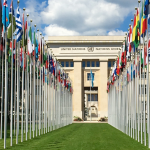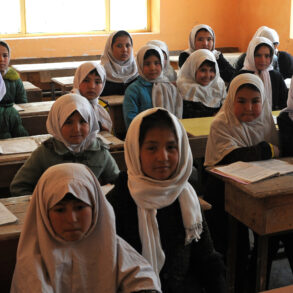
The International Convention on the Suppression and Punishment of the Crime of Apartheid (the “Apartheid Convention”) is a much understudied and overlooked human rights treaty. This is surprising given how often apartheid is mentioned in public discourse. The Apartheid Convention was adopted by the UN General Assembly on 30 November 1973, and entered into force on 18 July 1976. Presently, 109 states are parties to the Convention. Despite the end of apartheid in South Africa, the treaty has never been denounced, and it remains in force.
Although the Apartheid Convention remains in force, it could be described as a dormant convention because its monitoring body was suspended in 1995. It is our considered view that the reasons for suspending the work of that body no longer hold. This is because there are States parties that claim that apartheid is being practised beyond Southern Africa — for example, in Rakhine State in Myanmar and in the Occupied Palestinian Territories. An apartheid claim is likely to arise in the proceedings instituted before the International Court of Justice, given that the question referred to the Court for an Advisory Opinion inquired into the legal consequences of Israel’s prolonged occupation, settlement, and annexation of Palestinian territory, including the “adoption of related discriminatory legislation and measures”.
A claim that apartheid is being perpetrated by the junta in Rakhine State, and by the Israeli authorities in Palestine, has already been made by several blue-chip human rights organisations; and yet, these organisations did not consider in their reports whether the Apartheid Convention’s treaty monitoring mechanism could be revived. What follows is a brief description of the Apartheid Convention, the work of its monitoring body, known as the “Group of Three”, the reasons why monitoring should be revived, given recent developments, and suggestions as to how this might be done.
The importance of the Apartheid Convention
The 1973 Apartheid Convention may be described as a hybrid treaty in that it combines elements of a human rights treaty with those of a penal treaty. In declaring apartheid to be a crime against humanity in Article I, the Convention anticipated the Rome Statute of the International Criminal Court that lists the crime of apartheid as among the crimes against humanity in Article 7 of its Statute.
Article II of the Apartheid Convention contains a detailed definition of the crime of apartheid and a listing of prohibited acts constituting the crime. Perhaps most notably, the Convention focuses on accountability for the crime of apartheid in Article III, ascribing international criminal responsibility for the crime in broad terms.
The Apartheid Convention’s monitoring body
Like other “core” human rights treaties, the Apartheid Convention established a mechanism for monitoring and reporting on the Convention’s implementation. However, unlike the other human rights treaties, the members of the monitoring body were neither independent nor expert. According to Article IX of the Apartheid Convention the monitoring body consisted of three representatives of States parties appointed by the Chairman of the UN Commission on Human Rights (the predecessor to the UN Human Rights Council). The group would meet for not more than five days to review States parties’ reports submitted under Article VII of the Convention. In practice, the Group of Three consisted of officials, sometimes including ambassadors, from the permanent missions of States parties in Geneva, who would serve only for a single session every two years.
The Group of Three reviewed 129 reports from 1978, when the group was first appointed, until 1993, the date of the last review. In addition to detailing what the States parties were doing to combat apartheid in Southern Africa, the reports also provided information on the legislative measures they had adopted to give effect to the penal provisions of the Apartheid Convention. In these reports, some states parties also commented on practices of apartheid beyond Southern Africa. For example, Belarus, Cuba, Iraq, Qatar, Syria, and the UAE referred to Israel’s policies and practices toward the Palestinian people as falling within the territorial scope of Article II of the Convention. In the Group’s meetings the reports were discussed with representatives of the reporting State party. After these meetings ended, the group submitted a report to the Commission on Human Rights summarizing its deliberations.
The release of Nelson Mandela in 1990 foreshadowed the coming end of apartheid in South Africa which had been the dominant focus of the Group of Three. The last meeting of the Group of Three was held in 1995, following the 1994 general election in South Africa, the country’s first multi-racial election held with universal adult suffrage that led to the inauguration of Mandela as President.
The suspension of the work of the Group of Three
During the final meeting of the Group of Three in 1995, the chairwoman of the group “welcomed the significant and very positive developments that had occurred in South Africa”. Given these developments and since (at that time) that there was “no claim by any State party that apartheid, as defined by the Convention, exists anywhere else than in southern Africa”, it was decided to suspend “for the time being” any further meetings of the Group of Three. However, this decision was taken, “without prejudice to any subsequent reactivation of the monitoring mechanism of the Convention”.
Significantly, when the Chairwoman proposed to suspend the work of the Group of Three, she noted that the Convention, as drafted, “applied to any country that might practise racial segregation under an institutionalized apartheid system”.
In its resolution on the Convention, the Commission on Human Rights acknowledged with appreciation the contribution of the Group of Three in international efforts to eradicate apartheid and, considering that “apartheid no longer exists anywhere”, decided to suspend the Group of Three.
The distinctive focus of the Group of Three
In view of trends of apartheid-like practices and policies that have developed in different regions of the world, from Rakhine State, to the Occupied Palestinian Territories, and even North Korea, since the suspension of the Group of Three over 25 years ago, we believe that the time has come to consider reactivating its work.
As the last meeting of the Group of Three noted, reporting on practices of apartheid and racial segregation was already covered by reports submitted under the International Convention on the Elimination of all Forms of Racial Discrimination (“ICERD”). Article 3 of ICERD provides that States parties “particularly condemn racial segregation and apartheid”. However, ICERD does not define apartheid, nor does it capture the emphasis in the Apartheid Convention on individual and institutional accountability for the crime.
What was distinctive about the work of the Group of Three was that it went beyond drawing attention to human rights violations and reporting on compliance with the penal provisions of the Apartheid Convention to holding individuals and institutions to account. Its primary aim was to seek accountability for crimes committed by non-state parties, since no state accused of apartheid would ever ratify it. The work of Group of Three included, inter alia, circulating the names of individuals, organizations, and institutions suspected of committing, aiding, or abetting the crime against humanity of apartheid (wherever it occurred) to all UN member states; drawing up a Statute for a permanent international penal tribunal; convening studies and working groups to think of ways to further implementation of the Convention; and drawing attention to the role of transnational corporations in sustaining apartheid.
In short, the work of the Group of Three was more activist in substance than either CERD or the Universal Periodic Review. It aimed to put pressure on governments that not only committed the crime of apartheid, but that supported it.
Reactivating the Apartheid Convention and reforming the monitoring mechanism
The Human Rights Council, established in 2006, as the successor body to the Commission on Human Rights, has emphasized accountability for violations of international human rights law, and international humanitarian law, in the dozens of commissions of inquiry, and other investigative bodies, that it has established since 2011. The effective reactivation of the Apartheid Convention through its monitoring mechanism would conform to current international approaches to investigating and reporting on crimes against humanity and serious human rights violations.
The “disappearance” of the Commission on Human Rights when it was replaced by the Human Rights Council in 2006, certainly did not mean that the Apartheid Convention and its monitoring mechanism would similarly disappear owing to the key role that had been assigned to the Commission under Articles IX and X. Similarly, were the Economic and Social Council (“ECOSOC”) to be reformed, the International Covenant on Economic, Social and Cultural Rights (“ICESCR”) and its treaty monitoring body would continue unaffected despite the original role assigned to ECOSOC in monitoring and reporting on the implementation of the Covenant (see Articles 17-22 of the ICESCR).
The intention of the UN General Assembly that the Human Rights Council would assume the ongoing responsibilities of the Commission on Human Rights, including with respect to the Apartheid Convention, is apparent from paragraphs 1, 5(g), and 6 of UN General Assembly resolution 60/251 (2006) establishing the Council, as well as in how the transition was carried out.
That said, we do not approach reactivating the Group of Three with rose-tinted glasses. That body and the reporting by States parties had its flaws. The most egregious of these was that the members of the Group were neither independent nor expert, but embassy officials who served during five days on what amounted to a temporary, part-time assignment. In contrast, all other treaty monitoring bodies are comprised of independent experts who are elected by States parties and who serve in their individual capacities for a period of four years. This approach has introduced important elements of professionalism, expertise, and continuity, which have fostered the widespread recognition of the authority of the human rights treaty bodies and respect for their decisions and recommendations.
Reactivating and “professionalizing” the Group of Three into a continuing body of independent experts would be one way to effectively reactivate the Apartheid Convention. An alternative monitoring mechanism could be considered as well, such as appointing a special rapporteur on the crime of apartheid and apartheid-like practices who would report annually to the UN Human Rights Council. The Apartheid Convention is flexible on revising its provisions, and the creation of the Committee on Economic, Social and Cultural Rights in 1985 by ECOSOC provides a relevant precedent for creating a more effective monitoring mechanism for an important human rights treaty.
It is our opinion that the Human Rights Council should request the Office of the High Commissioner on Human Rights to submit a report on the implementation of the Apartheid Convention with proposals for operationalizing and reintegrating it into the other international human rights mechanisms.
Conclusion
Institutionalised systems of racial discrimination and domination, unfortunately, did not disappear from the world with the establishment of democracy in Southern Africa. On the contrary, apartheid-like practices have developed in different regions of the world as the forces of racism and ethno-nationalism have been encouraged and harnessed by extremist leaders seeking to attain or retain power. Concerned governments and human rights activists need all the tools available to combat this resurgence, which threatens increasing violence and undermines international cooperation at a time when it is needed most. The Apartheid Convention is potentially a unique and important tool in this effort and the time has come to effectively reactivate its provisions and integrate the Convention into current international human rights protection mechanisms.
This post was originally published on this site be sure to check out more of their content.








